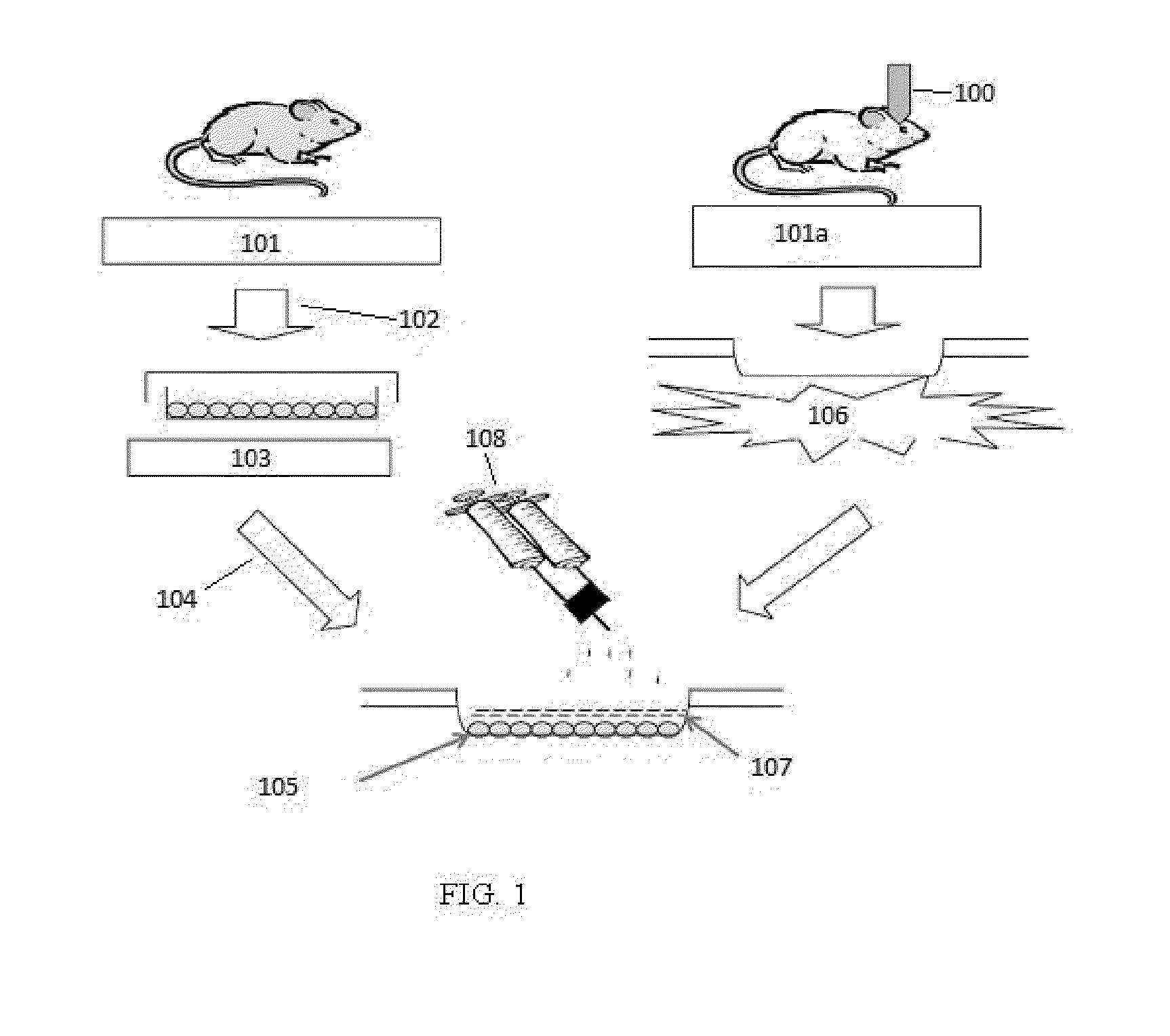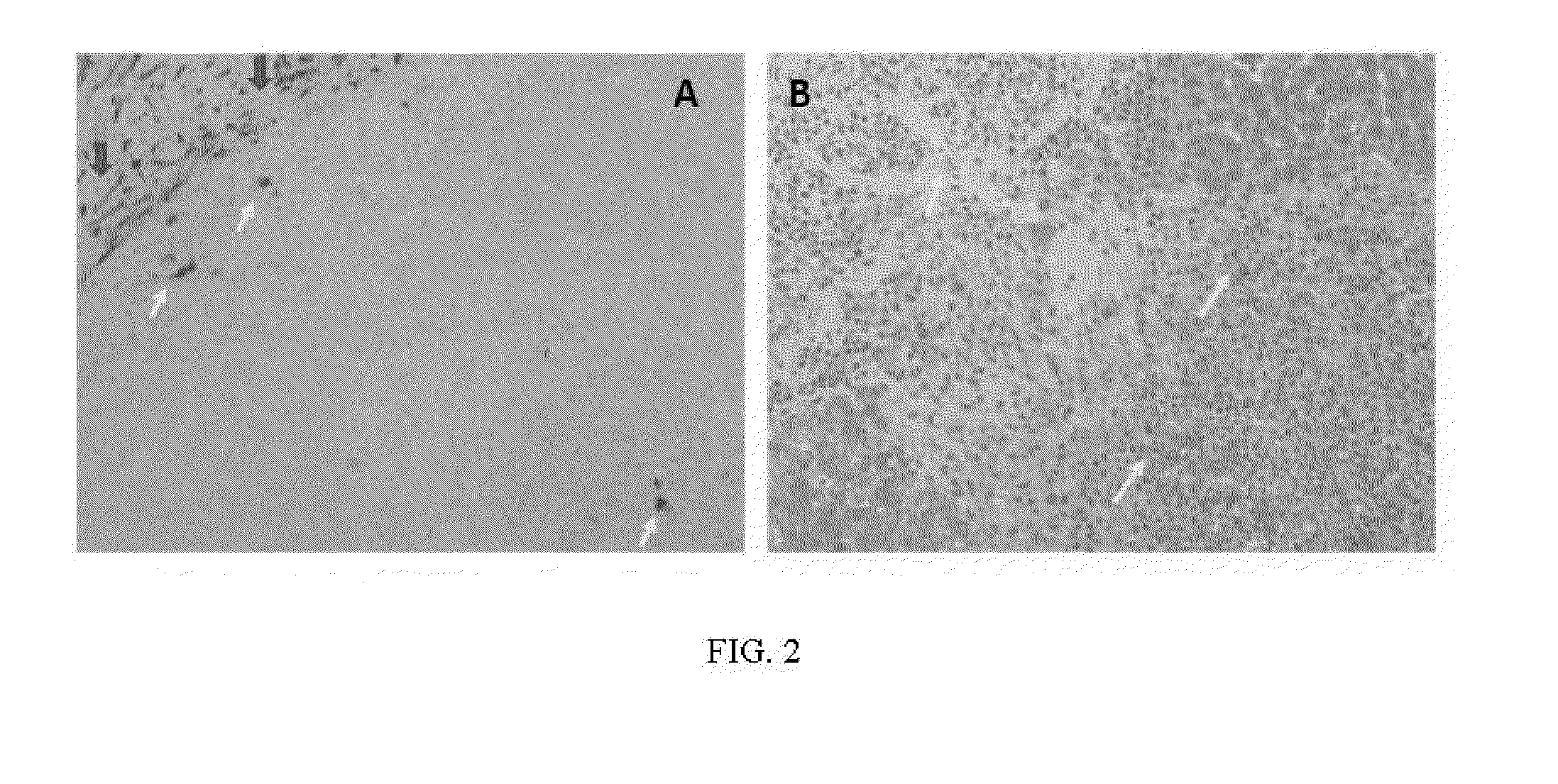Exogenous matrix-supported topical application of stem cells to organ surface
a stem cell and exogenous matrix technology, applied in the field of tissue regeneration, can solve the problems of affecting the use of stem cells, affecting the ability of donors to recover, and the process of obtaining and isolating stem cells is difficult and costly, and achieves the effects of increasing the level of cytokines, chemokines, growth factors, and anti-apoptotic or anti-necrotic factors in the tissu
- Summary
- Abstract
- Description
- Claims
- Application Information
AI Technical Summary
Benefits of technology
Problems solved by technology
Method used
Image
Examples
example 1
Isolation, culture, and characterization of adipose-tissue derived mesenchymal stem cells (ADMSC). Abdominal subcutaneous adipose tissue is taken from transgenic green fluorescent protein (GFP) Sprague-Dawley rats (SD-Tg (CAG-EGFP) CZ-0040sb, 12-week-old males) (see FIG. 1). The tissues are minced, digested with type I collagenase (Sigma-Aldrich, St. Louis, Mo.) for 30 minutes and then passed through a 100 μm filter to discard the cell debris. The cell pellets are suspended in DMEM containing 10% FBS, 100U penicillin / 100 μg streptomycin / 0.25 μg fungizone and cultured at 37° C. and 5% CO2 in humidified incubator. Techniques are essentially as described by Andreas S, and Christa B., Stem Cells, 2007; 25: 818-827; Mothe A J, et al., J Histochemistry &Cytochemistry, 2005; 53: 1215-1226; and Tao W, et al., Stem Cells, 2007; 25: 670-678, the contents of each of which are incorporated herein by reference.
The phenotype of ADMSCs is determined by flow cytometry (Becton Dickinson) using phyco...
example 2
MSCs are first derived from the subcutaneous adipose tissue of transgenic Sprague-Dawley (SD) rats expressing green fluorescent protein (GFP). The MSCs express CD90 (79%), but not CD45, and are capable of in vitro adipogenic, chrondrogenic and osteogenic differentiation under selective culture conditions. To stimulate the mobilization of the topically applied MSCs, experimental models of severe ischemia-reperfusion injury (IRI) of kidney, liver and small intestine are induced in test wild-type SD rats (N=19) by occlusion of kidney pedicle for 40 minutes (3); clamping portal vein and hepatic artery and bile duct for 30 minutes (4); and occlusion of main vascular pedicle, together with ligation of collateral vessels to the bowel segment for 90 minutes (5).
Two days after the IRI, 7×106 GFP-MSCs at passage 2-3 suspended in 200 μl phosphate buffer saline are applied directly to the organ surfaces of the ischemic kidney, liver and small intestine of the test animals (N=9). A thin layer of...
example 3
Rat traumatic brain injury model: A controlled cortical impact (CCI) device is used to produce model of traumatic brain injury (TBI) in wild-type SD rats essentially as described by Prins M L, et al., J Neurosci Res, 2005; 82(3):413-20; and Ringger, N. C., et al., J. Neurotrauma, 2005; 21, 1443-1456, the contents of each of which are incorporated herein by reference. CCI is used to generate injured brain tissue and CSF samples. Adult male (280-300 g) Sprague-Dawley rats (Harlan) are anesthetized with 4% isoflurane in a carrier gas of 1:1 O2 / N2O (4 min) followed by maintenance anesthesia of 2.5% isoflurane in the same carrier gas. Core body temperature is monitored and maintained at 37° C. Animals are mounted in a stereotactic frame and a unilateral craniotomy (7 mm diameter) is performed adjacent to the central suture, midway between bregma and lambda. The dura mater is kept intact over the cortex. Brain trauma is produced using a Benchmark™ Stereotaxic Impactor (MyNeurolab) by impa...
PUM
| Property | Measurement | Unit |
|---|---|---|
| diameter | aaaaa | aaaaa |
| temperature | aaaaa | aaaaa |
| velocity | aaaaa | aaaaa |
Abstract
Description
Claims
Application Information
 Login to View More
Login to View More - R&D
- Intellectual Property
- Life Sciences
- Materials
- Tech Scout
- Unparalleled Data Quality
- Higher Quality Content
- 60% Fewer Hallucinations
Browse by: Latest US Patents, China's latest patents, Technical Efficacy Thesaurus, Application Domain, Technology Topic, Popular Technical Reports.
© 2025 PatSnap. All rights reserved.Legal|Privacy policy|Modern Slavery Act Transparency Statement|Sitemap|About US| Contact US: help@patsnap.com



